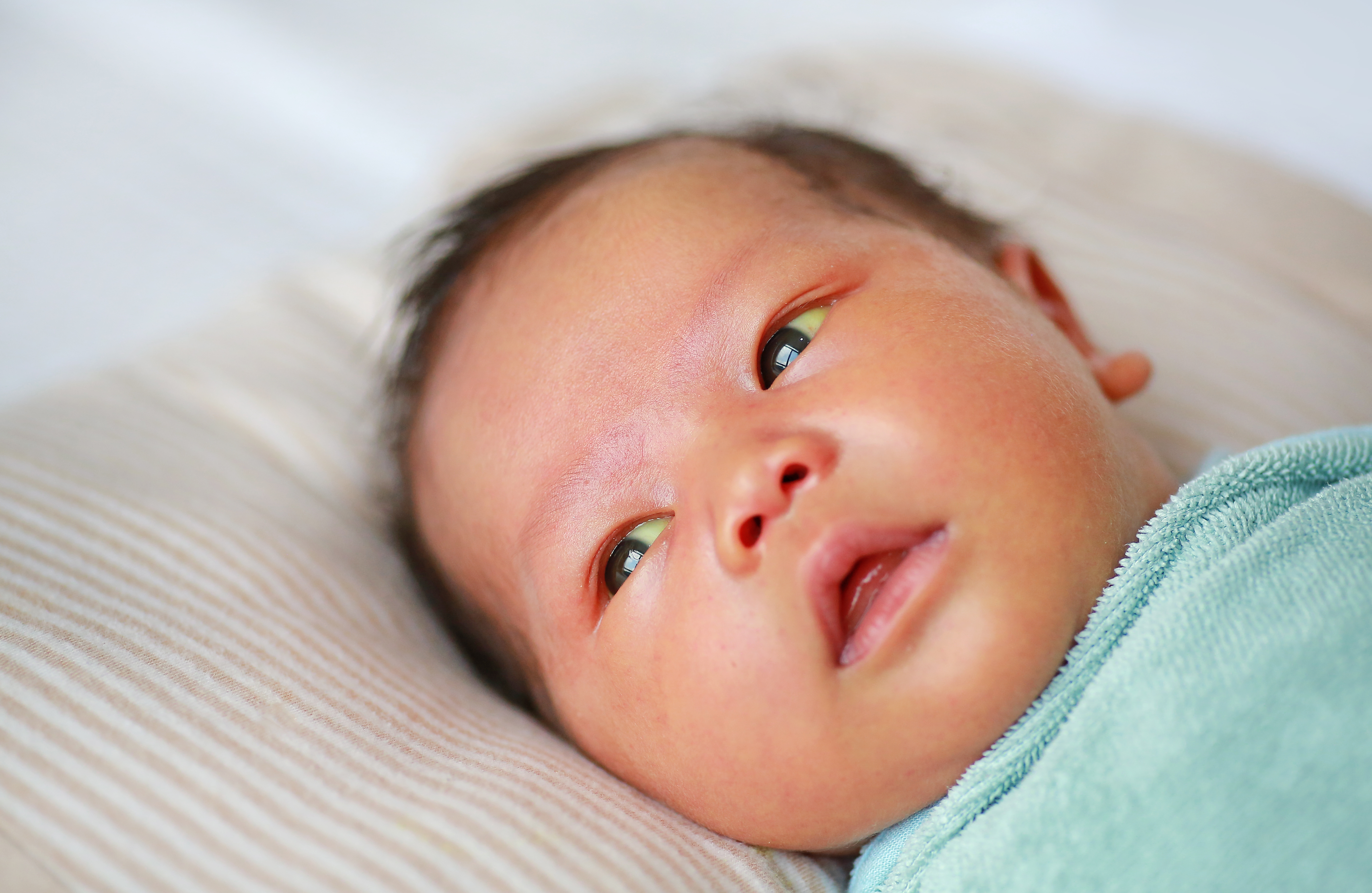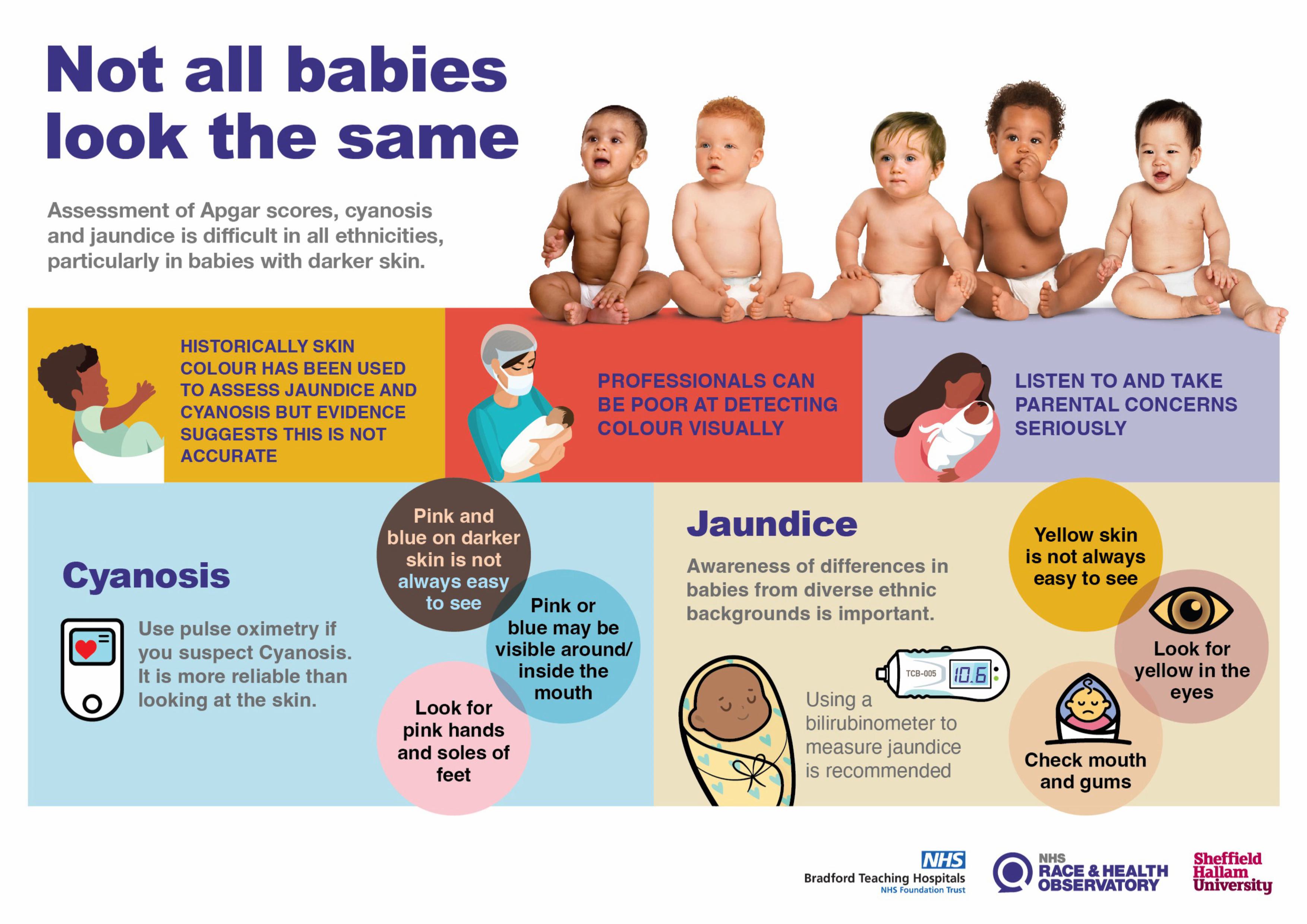If you are unsure about the advice given below, please contact 111 or your GP for futher assistance.
My baby is yellow / jaundice

Jaundice is extremely common and affects 6 out of every 10 babies. It causes yellowing of the skin and eyes. It is more common in preterm babies (born before 37 weeks). Jaundice usually develops 2 to 3 days after birth and disappears by two weeks of age. It is usually harmless. If your baby looks very yellow, health care professionals may do blood tests to check the 'level' of jaundice.
Yellowing of the skin may be more difficult to see in darker skin tones. It might be easier to see on the palms of the hands or the sole of the feet. Medway NHS Foundation Trust has developed 7 STEPS FOR JAUNDICE POSTER to help spot jaundice in black and brown babies.
For more information on jaundice visit the Health for Under 5's website.
You can visit NICE for more information on jaundice.
When should you worry?
- Unable to wake (unrousable)
- Rhythmic jerky movements of arms or legs (a seizure)
- Pauses in breathing or irregular breathing pattern
- Pale, mottled and feels abnormally cold to touch
- Is under 1 month of age with a temperature of 38°C / 100.4°F or above
You need urgent help.
Go to the nearest Hospital Emergency (A&E) Department or phone 999
- Jaundice appears in the first 24 hours of life
- Rapid progression in the intensity of 'yellowness'
- Looks very pale and yellow
- Becoming increasingly sleepy and less interested in feeding
- Unable to settle (inconsolable)
- No wet nappies in the last 8 hours
- Extremely pale (chalk coloured) stool - keep a sample to show the doctor
- Jaundice remaining beyond 2 weeks of life (after 3 weeks of life in a premature baby)
- Is 1-3 months of age with a temperature of 38°C / 100.4°F or above (but fever is common in babies up to 2 days after they receive vaccinations)
You need to contact a doctor or nurse today.
Please ring your Midwife, Health visitor or GP surgery or call NHS 111 - dial 111
- Baby looks lightly yellow, mainly on face, which can progress to a mild to moderate intensity in the next day or two, before fading away completely over the next two weeks.
- Continues to feed well, breast or formula. Has plenty of wet nappies and continues to pass green poo on day 2-3 changing to yellow "seedy" by day 5. Breast fed babies poo can appear "seedy" which are fat deposits within their poo and are a reassuring sign your baby is being well fed.
- Baby wakes up/cries regularly for feeds.
- Additional advice is also available for families to help cope with crying in otherwise well babies – click here.
Self care
Continue providing your child’s care at home. If you are still concerned about your child contact your Health Visitor or call NHS 111 – dial 111

Why do babies get jaundice?
It is completely normal for babies to get mildly jaundiced. That's because babies are born with high levels of red cells in their blood. After birth, as these red cells break down, they produce a yellow pigment called bilirubin. Bilirubin is normally removed by the liver, but as babies have an immature liver at birth, it can take up to 2 weeks for the bilirubin to clear. Breast feeding can cause mild jaundice as well - however the benefits of breastfeeding far outweigh the mild jaundice that may results.
In a small number of cases, there may be an underlying reason for a baby becoming severely jaundiced. This includes blood group incompatibility between the mother and baby, higher than normal level of red cells in the baby (polycythaemia) or genetic problems with the red cells. If there is a family history of red cell problems, please let your midwife know during pregnancy - your baby may need special tests after birth.
Jaundice occasionally persists beyond two weeks of age (beyond three weeks for babies born preterm - less than 37 completed weeks). If this happens, your baby is likely to be called into the hospital for further blood tests to find out reasons for the prolongation. In most instances, the cause for this is just your baby's liver taking a little longer to adapt (physiological jaundice) or breast milk jaundice. Neither of these are a problem for your baby. We also check the baby for much rarer causes of prolonged jaundice including urine infections, congenital viral infections (CMV), metabolic conditions (G6PD) and biliary atresia. Fortunately, these conditions are very rare and in most instances, the jaundice settles without any treatment.
How will my baby get checked for jaundice?
All newborn babies get a full head to toe examination within 72 hours of being born. In some instances, jaundice is picked up during this examination. If your baby develops jaundice at home, in most situations, they will not need to see a healthcare professional unless they have any red or amber features (see above). If your baby falls within 'Amber', see a GP or Community Midwife urgently as a blood test may be needed to check their jaundice 'level'. If your baby has any 'Red' features, they will need to be immediately assessed in hospital - dial 999 and ask for assistance from the emergency services.
For more information about testing for jaundice, click here.
Feeding your baby during jaundice:
Continue to feed your baby as planned. If you are breastfeeding your baby, continue to breast feed regularly and wake up your baby for feeds, if necessary. Formula supplementation, if not by choice, should only be considered if recommended by medical professionals.
Treatment of neonatal jaundice:
In a vast majority of babies, jaundice does not need treatment and should resolve completely by two weeks of age. Treatment is needed only if the baby's jaundice 'level' is high and likely to rise further without treatment. This decision will be made by a healthcare professional after they have checked the baby's jaundice 'level' either with a blood test or by using a hand-held device (which, if high, needs to be confirmed by a blood test).
The most common form of treatment is phototherapy. This is where a baby is kept exposed under special light in the hospital. This light alters the pigment bilirubin and makes it easier to be processed by the liver. Phototherapy can be administered on the postnatal ward or children's ward. If the jaundice level does not come down as expected, then this treatment may need to be 'intensified'. Click here for a video on phototherapy.
In very rare instances, where this treatment fails to control the rising level of bilirubin, they may need to undergo a process called an exchange transfusion - where almost all of the baby's blood is exchanged with matching donor blood. This is the most aggressive form of treatment that allows to bring down the bilirubin levels rapidly, thus preventing damage to their brain. Phototherapy lights are very effective these days and it is extremely rare for an exchange transfusion to be needed. In cases of blood group incompatibility, intravenous immunoglobulin may be given to prevent the need for an exchange transfusion.
For further information on treating neonatal jaundice, click here.
Complications
In a vast majority of babies, jaundice does not lead to any long-term complications. However, in less than 1 in 100,000 babies, extremely high levels of jaundice may affect the baby's brain leading to a condition called kernicterus.
For wear and tear, minor trips and everything in between.
Self-care
You can treat your child's very minor illnesses and injuries at home.
Some illnesses can be treated in your own home with support and advice from the services listed when required, using the recommended medicines and getting plenty of rest.
Sound advice
Children can recover from illness quickly but also can become more poorly quickly; it is important to seek further advice if a child's condition gets worse.
For information on common childhood illnesses go to What is wrong with my child?
Pharmacists are experts in many aspects of healthcare and can offer advice on a wide range of long-term conditions and common illnesses such as coughs, colds and stomach upsets. You don’t need an appointment and many have private consultation areas, so they are a good first port of call. Your pharmacist will say if you need further medical attention.
Sound advice
- Visit a pharmacy if your child is ill, but does not need to see a GP.
- Remember that if your child's condition gets worse, you should seek further medical advice immediately.
- Help your child to understand - watch this video with them about going to the pharmacy.
For information on common childhood illnesses go to What is wrong with my child?
Health visitors are nurses or midwives who are passionate about promoting healthy lifestyles and preventing illness through the delivery of the Healthy Child Programme. They work with you through your pregnancy up until your child is ready to start school.
Health Visitors can also make referrals for you to other health professionals for example hearing or vision concerns or to the Community Paediatricians or to the child and adolescent mental health services.
Contact them by phoning your Health Visitor Team or local Children’s Centre.
Sound advice
Health visitors also provide advice, support and guidance in caring for your child, including:
- Breastfeeding, weaning and healthy eating
- Exercise, hygiene and safety
- Your child’s growth and development
- Emotional health and wellbeing, including postnatal depression
- Safety in the home
- Stopping smoking
- Contraception and sexual health
- Sleep and behaviour management (including temper tantrums!)
- Toilet training
- Minor illnesses
For more information watch the video: What does a health visitor do?
Midwives provide advice, care and support for women and their babies during pregnancy, labour and the early postnatal period. They provide health education and parenting advice until care is transferred to a health visitor. This usually happens when your baby is about 2 weeks old.
Sound Advice
A midwife is an expert in normal pregnancy and birth.
You can find out more information about your local midwifery team by clicking here.
GPs assess, treat and manage a whole range of health problems. They also provide health education, give vaccinations and carry out simple surgical procedures. Your GP will arrange a referral to a hospital specialist should you need it.
Sound advice
You have a choice of service:
- Doctors/GPs can treat many illnesses that do not warrant a visit to A&E.
- Help your child to understand – watch this video with them about visiting the GP or going to a walk in centre
For information on common childhood illnesses go to What is wrong with my child?
If you’re not sure which NHS service you need, call 111. An adviser will ask you questions to assess your symptoms and then give you the advice you need, or direct you straightaway to the best service for you in your area.
Sound advice
Use NHS 111 if you are unsure what to do next, have any questions about a condition or treatment or require information about local health services.
For information on common childhood illnesses go to What is wrong with my child?
A&E departments provide vital care for life-threatening emergencies, such as loss of consciousness, suspected heart attacks, breathing difficulties, or severe bleeding that cannot be stopped. If you’re not sure it’s an emergency, call 111 for advice.


